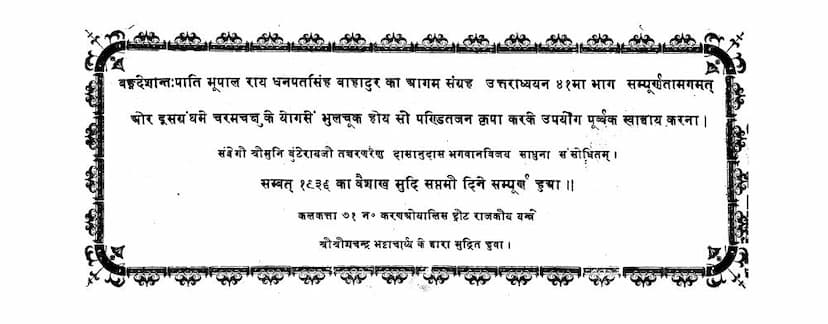Agam 43 Mool 04 Uttaradhyayan Sutra Shwetambar
Added to library: September 1, 2025

Summary
This document appears to be a portion of a Jain text, specifically the Uttaradhyayana Sutra, with extensive commentary (Tika). The provided text spans multiple pages and covers sections related to the teachings of Lord Mahavir, emphasizing virtuous conduct, the nature of the soul, and the path to liberation.
Here's a breakdown of the content based on the provided snippets:
Book Information:
- Book Title: Agam 43 Mool 04 Uttaradhyayan Sutra Shwetambar
- Author: Rai Dhanpatsinh Bahadur
- Publisher: Rai Dhanpatsinh Bahadur
- Catalog Link: https://jainqq.org/explore/007381/1
- Usage: JAIN EDUCATION INTERNATIONAL FOR PRIVATE AND PERSONAL USE ONLY
Key Themes and Content:
-
Praise and Dedication (Page 3): The text begins with invocations and praise to Jain deities and spiritual guides, particularly highlighting the significance of the Panchaachara (five great virtues) and the teachings of Lord Mahavir. It mentions the existence of various commentaries on the Uttaradhyayana Sutra and the author's humble attempt to present a new one.
-
Importance of Vinaya (Discipline/Respect) (Pages 3-18, and mentioned in the title/structure): The initial chapters (implied by "Vinay Adhyayan") focus heavily on the concept of vinaya. This includes:
- Definition and Importance: Vinaya is presented as the root of Jain dharma and the path to liberation.
- Characteristics of a Disciplined Disciple: The text describes the qualities of a good disciple, such as obedience to the guru, understanding the guru's intentions, humility, attentiveness, and proper conduct.
- Characteristics of an Undisciplined Disciple: Conversely, it outlines the negative traits of an undisciplined individual, such as disobedience, fault-finding, disrespect, and ignorance.
- Illustrative Stories: Several stories are used to highlight the importance and consequences of vinaya and its absence. The story of the undisciplined disciple (Koolwaloo) and the virtuous disciple (often contrasted with the undisciplined one through examples like Chandrura Acharya or the story of the elephant trained by its master) are prominent.
-
Parishaha (Endurance of Hardships) (Pages 51-104, and mentioned in the structure): A significant portion of the text is dedicated to the concept of parishaha, which are the twenty-two types of hardships or trials that a Jain monk must endure with equanimity. The text meticulously lists and explains each parishaha, often accompanied by illustrative stories:
- List of Parishaha: Hunger, thirst, cold, heat, insect bites, nakedness, lack of wealth, illness, indifference, spiritual ignorance, self-control, vinaya (in the context of enduring hardship), pride, ignorance, encountering the unpleasant, asking for alms, etc.
- Stories: Numerous anecdotes are used to demonstrate how monks should face these parishahas with equanimity, detachment, and faith in Jain principles. Examples include the story of the monk who endured extreme hunger, the monk who faced harsh weather, and the monk who maintained composure when attacked by insects.
-
The Importance of Self-Control and Detachment (Multiple Sections): Across various chapters, the text consistently emphasizes the need for samyama (self-control) and vairagya (detachment) from worldly pleasures, possessions, and attachments. This is crucial for spiritual progress and achieving liberation.
-
The Path to Liberation (Moksha) (Implied throughout): The ultimate goal of Jain practice, moksha (liberation), is the underlying theme. Vinaya, parishaha, samyama, and vairagya are presented as essential steps on this path.
-
Ethical Conduct and Virtues (Multiple Sections): The text delves into various ethical principles and virtues that laypeople and ascetics should cultivate, including truthfulness, non-violence, contentment, and overcoming desires.
-
The Nature of Reality and the Soul (Implied): While not explicitly detailed in these snippets, Jain scriptures like the Uttaradhyayana Sutra generally discuss the nature of the soul (jiva), its bondage, and the means to achieve liberation from the cycle of birth and death (samsara).
-
Illustrative Narratives: The text heavily relies on stories (kathas) and examples to convey its teachings. These narratives often feature kings, princes, merchants, monks, and even divine beings, illustrating the practical application of Jain principles in daily life and spiritual practice.
-
Structure of the Text: The snippets suggest a structured approach, likely divided into chapters (adhyayan) and verses (sutras), with detailed explanations and elaborations provided by the commentator. The recurring mention of chapter numbers (e.g., "Adhyayan 1," "Adhyayan 2") and the overall tone indicate a comprehensive discourse.
Overall Message:
The core message of this portion of the Uttaradhyayana Sutra is the paramount importance of virtuous conduct, self-discipline, and detachment for achieving spiritual purification and liberation. It emphasizes that worldly pleasures and attachments are temporary and ultimately lead to suffering, while adherence to Jain principles, enduring hardships with equanimity, and cultivating self-control are the true paths to lasting peace and salvation. The text uses rich narratives and examples to make these profound teachings accessible and relatable.